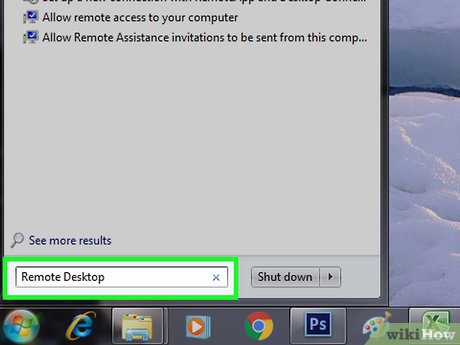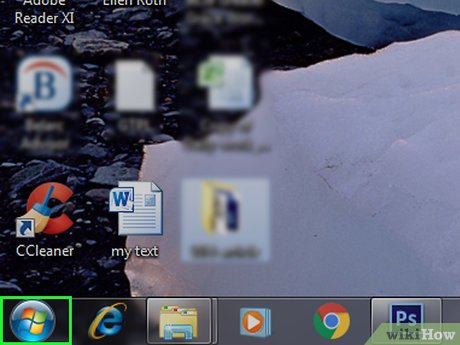How to Use Remote Desktop in Windows 7
Part 1 of 4:
Enabling Remote Desktop
-
 Make sure that you meet the criteria for enabling Remote Desktop. In order to turn on Remote Desktop, you must be on an account that has administrator privileges, and the account must have a password enabled.
Make sure that you meet the criteria for enabling Remote Desktop. In order to turn on Remote Desktop, you must be on an account that has administrator privileges, and the account must have a password enabled. -
 Open Start. Click the multicolored Windows logo in the bottom-left corner of the screen. The Start menu will pop up.
Open Start. Click the multicolored Windows logo in the bottom-left corner of the screen. The Start menu will pop up.
-
 Click Control Panel. It's on the right side of the Start menu. Doing so opens the Control Panel window.
Click Control Panel. It's on the right side of the Start menu. Doing so opens the Control Panel window. -
 Set the "View by" option to "Large icons". Click the "View by:" drop-down box in the upper-right side of the Control Panel window, then click Large icons in the resulting drop-down menu.
Set the "View by" option to "Large icons". Click the "View by:" drop-down box in the upper-right side of the Control Panel window, then click Large icons in the resulting drop-down menu.- If you already see "Large icons" next to the "View by:" heading, skip this step.
-
 Click System. It's a heading near the bottom of the window.
Click System. It's a heading near the bottom of the window.- You may have to scroll down to see this option.
-
 Click Remote settings. This link is in the upper-left corner of the window. Doing so opens a new window.
Click Remote settings. This link is in the upper-left corner of the window. Doing so opens a new window. -
 Check the "Allow Remote Assistance connections to this computer" box. It's at the top of the new window.
Check the "Allow Remote Assistance connections to this computer" box. It's at the top of the new window.- If you don't see this option, first make sure you're on the right tab by clicking Remote at the top of the window.
- Skip this step if the box is already checked.
-
 Check the "Allow connections from computers running any version of Remote Desktop" box. It's in the middle of the pop-up window. Doing so allows you to connect to this computer from any computer that runs Remote Desktop (e.g., a Windows 10 computer) in the future.
Check the "Allow connections from computers running any version of Remote Desktop" box. It's in the middle of the pop-up window. Doing so allows you to connect to this computer from any computer that runs Remote Desktop (e.g., a Windows 10 computer) in the future.- Skip this step if this box is already checked.
-
 Add more users if necessary. If you want to allow Remote Desktop access to another user account on the target computer, do the following:
Add more users if necessary. If you want to allow Remote Desktop access to another user account on the target computer, do the following:- Click Select Users….
- Click Add.
- Click Advanced….
- Click Find Now.
- Scroll down in the pane at the bottom of the window and double-click the name of the user you want to add.
- Click OK on the top two open windows.
-
 Click OK. It's at the bottom of the window. Doing so saves your settings and enables Remote Desktop on your target computer.
Click OK. It's at the bottom of the window. Doing so saves your settings and enables Remote Desktop on your target computer.
Part 2 of 4:
Allowing Remote Desktop in Firewall Settings
-
 Click Control Panel Home. This link is in the upper-left corner of the window. Doing so takes you back to the main Control Panel window.
Click Control Panel Home. This link is in the upper-left corner of the window. Doing so takes you back to the main Control Panel window.- If you closed Control Panel, re-open it before proceeding.
-
 Click Windows Firewall. It's in the list of Control Panel options.
Click Windows Firewall. It's in the list of Control Panel options. -
 Click Allow an app or feature through Windows Firewall. This link is in the top-left corner of the page.
Click Allow an app or feature through Windows Firewall. This link is in the top-left corner of the page. -
 Click Change settings. It's at the top of the page, just above the list of programs in the middle.
Click Change settings. It's at the top of the page, just above the list of programs in the middle. -
 Scroll down and check the "Remote Desktop" box. You'll find it in the "R" section of the list of programs. Doing so will allow Remote Desktop through the Windows Firewall.[1]
Scroll down and check the "Remote Desktop" box. You'll find it in the "R" section of the list of programs. Doing so will allow Remote Desktop through the Windows Firewall.[1] -
 Click OK. It's at the bottom of the window. This saves your changes.
Click OK. It's at the bottom of the window. This saves your changes.
Part 3 of 4:
Finding the Target Computer's Address
-
 Consider setting a static IP address. This is optional, but recommended. A static IP address won't change when your router disconnects or your computer reconnects to the network, meaning that the IP address you find now will work in the future; failing to do this means you'll need to find the IP address of the target computer whenever you want to connect to it. To set a static IP address, you'll need to go into your router's settings:[2]
Consider setting a static IP address. This is optional, but recommended. A static IP address won't change when your router disconnects or your computer reconnects to the network, meaning that the IP address you find now will work in the future; failing to do this means you'll need to find the IP address of the target computer whenever you want to connect to it. To set a static IP address, you'll need to go into your router's settings:[2]- Find your router's IP address.
- Go to your router's IP address in a web browser and log in with your router's credentials if prompted.
- Find the list of currently connected computers and select your computer.
- Make the IP address static by clicking the lock icon or similar.
- Wait for your router to finish rebooting.
-
 Open a web browser. On the target computer, click or double-click the app icon for a web browser (e.g., Chrome).
Open a web browser. On the target computer, click or double-click the app icon for a web browser (e.g., Chrome). -
 Open WhatIsMyIP. Go to https://www.whatismyip.com/ in the target computer's web browser.
Open WhatIsMyIP. Go to https://www.whatismyip.com/ in the target computer's web browser. -
 Find your public IP address. Next to the "Your Public IPv4 is" heading at the top of the page, you'll find your target computer's public IP address.
Find your public IP address. Next to the "Your Public IPv4 is" heading at the top of the page, you'll find your target computer's public IP address. -
 Log out of the target computer. Click Start, click theicon in the bottom-right corner of the Start menu, and click Log off. At this point, you're free to proceed with connecting to your target computer with a different Windows 7 computer.
Log out of the target computer. Click Start, click theicon in the bottom-right corner of the Start menu, and click Log off. At this point, you're free to proceed with connecting to your target computer with a different Windows 7 computer.
Part 4 of 4:
Connecting via Remote Desktop
-
 Open Starton a different computer. Click the Windows logo in the bottom-left corner of the screen.
Open Starton a different computer. Click the Windows logo in the bottom-left corner of the screen.
-
 Click the search bar. It's at the bottom of the Start window.
Click the search bar. It's at the bottom of the Start window. -
 Search for Remote Desktop. Type in remote desktop to do so. You should see a list of results appear in the Start window.
Search for Remote Desktop. Type in remote desktop to do so. You should see a list of results appear in the Start window. -
 Click Remote Desktop Connection. This should be the top result in the Start menu. Doing so opens the Remote Desktop window.
Click Remote Desktop Connection. This should be the top result in the Start menu. Doing so opens the Remote Desktop window.- You may instead just click Remote Desktop here.
-
 Enter the IP address of the target computer. Click the "Computer" text box in the middle of the Remote Desktop window, then type in the target computer's public IP address.
Enter the IP address of the target computer. Click the "Computer" text box in the middle of the Remote Desktop window, then type in the target computer's public IP address. -
 Click Connect. It's at the bottom of the window.
Click Connect. It's at the bottom of the window. -
 Enter the login credentials for the target computer. When prompted, type in the administrator name and password for the account on which you enabled Remote Desktop.
Enter the login credentials for the target computer. When prompted, type in the administrator name and password for the account on which you enabled Remote Desktop.- If you added another user to Remote Desktop, you can enter their credentials instead to access their account.
-
 Click OK. It's at the bottom of the window. Doing so connects your computer to the target computer, though it may take several minutes for the connection to finalize; once you see the other computer's desktop appear in Remote Desktop, you're free to peruse your remote computer as you please.
Click OK. It's at the bottom of the window. Doing so connects your computer to the target computer, though it may take several minutes for the connection to finalize; once you see the other computer's desktop appear in Remote Desktop, you're free to peruse your remote computer as you please.
5 ★ | 1 Vote
You should read it
- Remote Desktop controls other computers in the LAN
- Instructions for activating and using Remote Desktop on Windows 10 computers
- How to Remove Chrome Remote Desktop on Windows
- The difference between Remote Desktop (RDP) and VPN
- Steps to Fix the error that cannot be copied and pasted into the Remote Desktop session
- 6 ways to disable Remote Desktop on Windows 11
- 5 best remote desktop applications for Linux to access remote computers
- How to Use Remote Desktop on Windows 8
May be interested
- Leaks information about Microsoft's new Remote Desktop application
 microsoft is actively deploying the new remote desktop client, optimized for their windows virtual desktop ...
microsoft is actively deploying the new remote desktop client, optimized for their windows virtual desktop ... - Setting up and connecting Remote Desktop in Windows 7
 microsoft's remote desktop manager feature in windows 7 can easily allow users to connect from one computer to another in the same network, and share documents, documents ... in the article below, we will show you a few basic steps in the process of setting up and using this feature in windows 7.
microsoft's remote desktop manager feature in windows 7 can easily allow users to connect from one computer to another in the same network, and share documents, documents ... in the article below, we will show you a few basic steps in the process of setting up and using this feature in windows 7. - Troubleshoot Remote Desktop problems
 remote desktop allows remote connection to your computer using the rdp protocol. however, when connecting you have some problems, read the following article.
remote desktop allows remote connection to your computer using the rdp protocol. however, when connecting you have some problems, read the following article. - 10 ways to open the Remote Desktop Connection tool in Windows 11
 remote desktop connection is windows 11's built-in application for connecting to remote computers. you can use it to remotely access another pc, which is useful for personal or support-related use.
remote desktop connection is windows 11's built-in application for connecting to remote computers. you can use it to remotely access another pc, which is useful for personal or support-related use. - Activate Remote Desktop in Vista and Windows 7
 in windows operating system, remote desktop function allows you to access remote systems via your local network or internet. this function is especially useful for network managers, administrators can access the screen of all remote computers and do whatever they want.
in windows operating system, remote desktop function allows you to access remote systems via your local network or internet. this function is especially useful for network managers, administrators can access the screen of all remote computers and do whatever they want. - How to Use Remote Desktop on Windows 7
 today's tipsmake will show you how to enable and use remote desktop on two windows 7 computers. remote desktop is built into windows 7, this feature allows users to control one computer from another computer via a connection. internet connection. to use remote desktop, you need to enable the feature on the target computer and find the ip address of this computer, then you can connect to the target computer from another computer.
today's tipsmake will show you how to enable and use remote desktop on two windows 7 computers. remote desktop is built into windows 7, this feature allows users to control one computer from another computer via a connection. internet connection. to use remote desktop, you need to enable the feature on the target computer and find the ip address of this computer, then you can connect to the target computer from another computer. - How to Remove Chrome Remote Desktop on Windows
 chrome remote desktop is a remote desktop app that allows users to remotely control another computer. it is developed by google and requires google chrome with chrome remote desktop as an extension. it's a good software to have, but if...
chrome remote desktop is a remote desktop app that allows users to remotely control another computer. it is developed by google and requires google chrome with chrome remote desktop as an extension. it's a good software to have, but if... - Configure Windows Remote Desktop from the command line
 in this article, i will show you how to use windows remote desktop (mstsc.exe) from the command line to connect to remote servers from saved shortcuts or other options.
in this article, i will show you how to use windows remote desktop (mstsc.exe) from the command line to connect to remote servers from saved shortcuts or other options. - Instructions for using Chrome Remote Desktop application on Android
 the chrome remote desktop application that google has just released allows you to control a windows or mac computer using an android device. here's how to read how to use the chrome remote desktop application for android that has just been released by google in the past few days.
the chrome remote desktop application that google has just released allows you to control a windows or mac computer using an android device. here's how to read how to use the chrome remote desktop application for android that has just been released by google in the past few days. - Remote Desktop controls other computers in the LAN
 use remote desktop to start a remote connection. remote desktop is a great way to work all computer systems from a central computer.
use remote desktop to start a remote connection. remote desktop is a great way to work all computer systems from a central computer.


































 How to Show Hidden Files in Windows 7
How to Show Hidden Files in Windows 7 How to Record Screen in Microsoft Windows 7
How to Record Screen in Microsoft Windows 7 How to Uninstall Internet Explorer 11 for Windows 7
How to Uninstall Internet Explorer 11 for Windows 7 How to Reformat Windows 7
How to Reformat Windows 7 How to Reset Windows 7 Administrator Password
How to Reset Windows 7 Administrator Password How to Format the C Drive With Windows 7
How to Format the C Drive With Windows 7